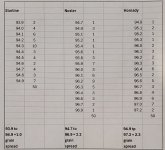I am starting to reload 223 for accuracy (5 shot groups at 100 yards on paper). I bought new brass from Starline, Hornady and Nosler (Lapua is always out of stock). I weighted 50 rounds each, here are the results (detail attached):
Starline 93.9 to 94.9 = 1.0 grain spread.
Hornady 94.7 to 96.9 = 2.2 grain spread
Nosler 94.9 to 97.2 = 2.3 grain spread
Does the weight difference matter and if so how should I sort? Where do I draw the line? Is there an established standard weight for new, unprimed .223 Rem. brass?
Thanks for any input.
Starline 93.9 to 94.9 = 1.0 grain spread.
Hornady 94.7 to 96.9 = 2.2 grain spread
Nosler 94.9 to 97.2 = 2.3 grain spread
Does the weight difference matter and if so how should I sort? Where do I draw the line? Is there an established standard weight for new, unprimed .223 Rem. brass?
Thanks for any input.


